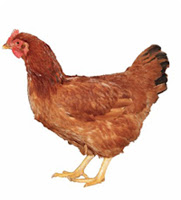The General Way Of Brooding Chicks
Chicks are newly hatched chickens. Chicks must be kept in a warm and safe environment. A child’s wading pool is a good choice for brooding Turkeys, Broilers, Layers, Cockerels, Noilers and even Ducks as such a place can be easily cleaned and have no corner that can cause chicks pile up and stampede of one another. Brooding is a crucial point in the bird's growth and development, it also helps in boosting bird's immunity against diseases. Failed brooding promotes stunted growth and spread of poultry infections.
Before the chicks arrival, you need to need to determine the space requirement. The feed and space requirements is based on the type of the bird, be it Broiler, Noiler, Layer, Cockerel or Turkey. The next step is to clean and disinfect the space, other facilities like drinkers, feeders, buckets thoroughly with detergent and disinfectant.
You need to evenly fill the brooder with few inches of wood shavings or cob litter but never use saw dust, it contains toxin. The saw dust could be picked by the chicks and cause digestive problems. You can cover the litter with paper for the first 5 days or a week to prevent the chicks from eating the litter.
The floor temperature of the brooder, where you groom the chicks, should be around 35 degree celsius, achieved through the use of heat lamps or any other source of heat. Each week, reduce the temperature by 5 degree celsius or so. The brooding process is over around 4 to 6 weeks depending on the feathering process and bird type. Matured birds perform optimally between the temperature of 18 to 24 degree celsius.
You need to evenly fill the brooder with few inches of wood shavings or cob litter but never use saw dust, it contains toxin. The saw dust could be picked by the chicks and cause digestive problems. You can cover the litter with paper for the first 5 days or a week to prevent the chicks from eating the litter.
The floor temperature of the brooder, where you groom the chicks, should be around 35 degree celsius, achieved through the use of heat lamps or any other source of heat. Each week, reduce the temperature by 5 degree celsius or so. The brooding process is over around 4 to 6 weeks depending on the feathering process and bird type. Matured birds perform optimally between the temperature of 18 to 24 degree celsius.
On the chicks arrival, unbox them into the already prepared brooder and discard the cartons far away from your farm or burn them outside the brooder immediately. This is a biosecurity measure as such cartons can easily harbour pathogens; disease causing organisms.
Now, the chicks need feed and water. Make it readily available to them at all times. For the first day or two, you can sprinkle chick starter feed on sheets of cardboard and later switch to tray feeders. A chick needs an inch of feeder space to start and three to four inches per bird as they grow. Water should be fresh and waterers cleaned daily. Read more about Poultry Feeding Program.
Apart from maintaining a good health management throughout the brooding period, farmers also need to observe the chicks closely by noticing any unusual signs. Are the birds drinking? Often baby birds need to be shown how to drink by dipping their beak in the waterer and tip their head back to help them swallow. Once this is done to like five different chicks, others will emulate. If they are piling up on each other, the temperature may be too low. If they spread out far away from the heat source, the temperature is too high. Thermometer can be installed not close to the heat source to ascertain the brooding temperature.
You may also like to read more about:
For quick updates and comments, follow us on our social media connects; FacebookPage, TwitterHandle and Instagram. You can also subscribe and watch videos on our YouTube channel. At Artib Farm, we materialize your satisfaction!




Comments
Post a Comment